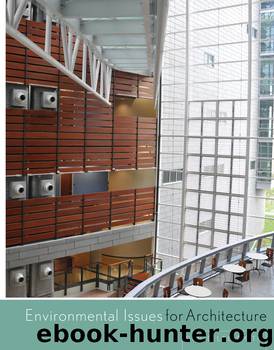Environmental Issues for Architecture by David Lee Smith

Author:David Lee Smith
Language: eng
Format: epub
ISBN: 9780470644355
Publisher: Wiley
Published: 2011-02-15T05:00:00+00:00
Eero Saarinen’s design for MIT’s Kresge Auditorium, shown in Figure 9.1, was an early attempt to connect the interior and the exterior. The major architectural component of the design was a long-span, thin-shell concrete dome, and the interior and exterior were to be separated merely by expansive glazing. Unfortunately, the potential movement of the shell as a result of temperature changes required the addition of heavy vertical framing to stabilize the edges of the shell so that the window glazing would be retained in place. This framing created more of a visual separation than desired. Even with these heavy steel members forming an edge to the space, Saarinen minimized the sill so that the brick paving used both inside and outside would seem to flow together. While initially there was some sense that the paving did continue, after a few years the interior paving, which had grouted joints and was cleaned and polished, appeared quite different from the exterior paving, which had open joints for water control and acquired a weathered patina. The continuous trench drain that surrounded the shell also violated the sense of connection.
Total or absolute isolation of interior and exterior is also not achievable and generally not desirable. Generally, any space that is located along a building perimeter should take advantage of the daylighting potentials and views, but even when this is not desired and considerable thermal insulation is added to the exterior envelope, some heat exchange is likely. As in larger buildings with major segments of interior space that are architecturally isolated from the exterior, some connections must still be established with the outside in order to condition these spaces adequately. For example, fresh air must be provided from the outside in order to ventilate the interior space, and the internal heat gains, which are a necessary by-product of occupancy, must be dissipated to the exterior by means of some mechanical device.
While the design intentions for a building’s envelope might be to achieve total connection or total isolation between the exterior and the interior, such intentions are seldom fully attainable. In most contemporary structures, rather than acting as a connector or a barrier, the building envelope operates partially as a filter, providing certain connections between the interior and the exterior, and partially as a switch, ameliorating the flow of forces between the two environments. While the architecture tends to play both of these roles, the role of switch is also fulfilled largely by the building’s mechanical ECS. The ECS are intended to counteract the natural flow of energy between the interior and the exterior, and to be effective, they should accomplish this at the point of this energy flow. Rather than merely achieve some sort of thermal balance, an ECS should control any thermal problems at their source. If the building envelope is allowing a flow of energy between the exterior and the interior, which conflicts with the desired interior conditions, then the ECS should counteract this flow. They do this by adding to or extracting
Download
This site does not store any files on its server. We only index and link to content provided by other sites. Please contact the content providers to delete copyright contents if any and email us, we'll remove relevant links or contents immediately.
Kathy Andrews Collection by Kathy Andrews(11310)
The remains of the day by Kazuo Ishiguro(8372)
Paper Towns by Green John(4784)
Spare by Prince Harry The Duke of Sussex(4773)
The Body: A Guide for Occupants by Bill Bryson(4569)
Industrial Automation from Scratch: A hands-on guide to using sensors, actuators, PLCs, HMIs, and SCADA to automate industrial processes by Olushola Akande(4554)
Be in a Treehouse by Pete Nelson(3638)
Harry Potter and the Goblet Of Fire by J.K. Rowling(3599)
Machine Learning at Scale with H2O by Gregory Keys | David Whiting(3560)
Never by Ken Follett(3509)
Goodbye Paradise(3435)
The Remains of the Day by Kazuo Ishiguro(3127)
Into Thin Air by Jon Krakauer(3121)
The Cellar by Natasha Preston(3073)
The Genius of Japanese Carpentry by Azby Brown(3032)
Drawing Shortcuts: Developing Quick Drawing Skills Using Today's Technology by Leggitt Jim(2936)
120 Days of Sodom by Marquis de Sade(2933)
Fairy Tale by Stephen King(2920)
The Man Who Died Twice by Richard Osman(2794)
